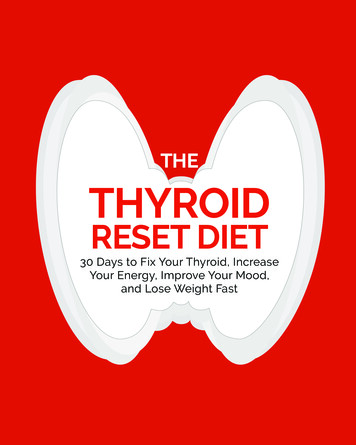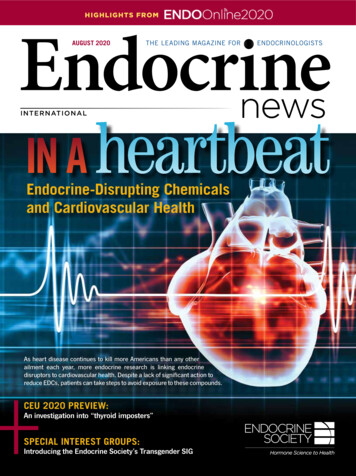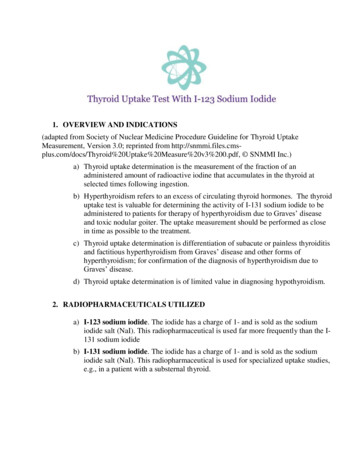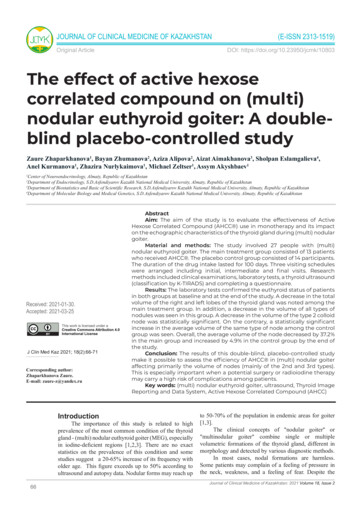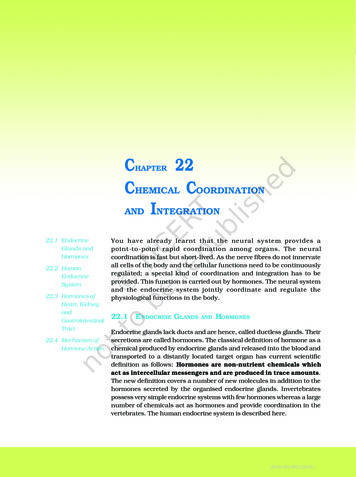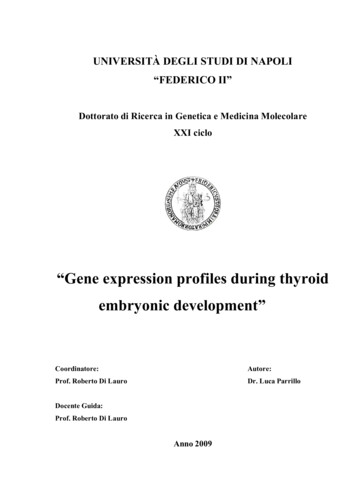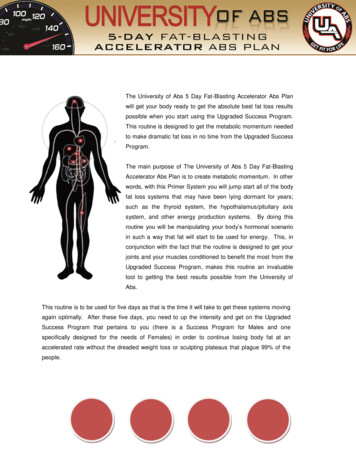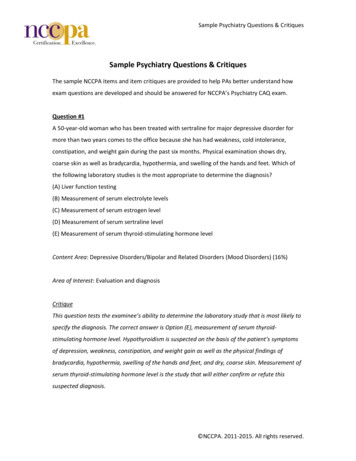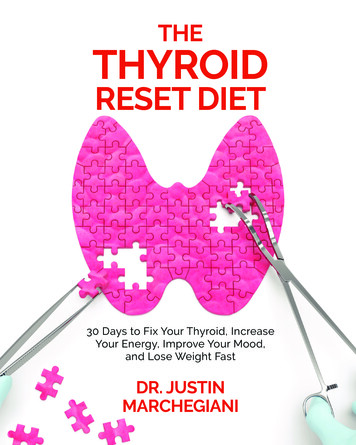
Transcription
THETHYROIDRESET DIET30 Days to Fix Your Thyroid, IncreaseYour Energy, Improve Your Mood,and Lose Weight FastDR. JUSTINMARCHEGIANI
2017 The Thyroid Reset DietAll rights reserved.No part of this publication may be reproduced, distributed, or transmitted in any form or byany means, including photocopying, recording, or other electronic or mechanical methods,without the prior written permission of the publisher, except in the case of brief quotationsembodied in reviews and certain other non-commercial uses permitted by copyright law.2
ContentsI.INTRODUCTION7A.B.C.D.E.F.Addressing the Root Cause of Thyroid SymptomsMy StoryAutoimmunity and Hashimoto’sStudying the Thyroid and Its ConnectionsFunctional Medicine vs. Conventional MedicineThe Structure of the BookII.CHAPTER 1:THE NUTS AND BOLTS OF THE THYROIDA.B.C.D.E.F.G.H.I.Introduction: What Is the Thyroid?What Does the Thyroid Do?How Does the Thyroid Work?The Thyroid’s Essential IngredientsConditions of the ThyroidThyroid Patient ExamThyroid Lab TestingThyroid Health and HealingFive Key Points to RememberIII. CHAPTER 2:THYROID-SUPPORTING DIET AND LIFESTYLEA.B.C.D.E.F.G.H.I.J.13IntroductionThree Major Criteria for the Thyroid Reset DietThe Blood-Sugar ConnectionThe Proteins, Fats, and Carbs ConnectionThyroid Diet and AutoimmunityDietary TipsDietary ToolsExerciseSleepFive Key Points to Remember337
IV. CHAPTER 3:THE GUT CONNECTIONA.B.C.D.E.F.G.IntroductionThe Importance of Stomach AcidThe Effects of Stress on the GutGut Bacteria and the ThyroidHow to Heal a Leaky GutTesting for Gut IssuesFive Key Points to RememberV.CHAPTER 4:THE ADRENAL l Dysfunction and FatigueAdrenal Stress and HealingWhy Is Cortisol so Important?The Adrenals and Blood SugarManaging the Stress: Conservation vs. AbundanceWhen Lions Attack: The Microstress EffectTests for the Adrenal GlandsFive Key Points to RememberVI. CHAPTER 5:THE GLUTEN CONNECTIONA.B.C.D.E.F.G.H.I.J.91IntroductionWhat Is Gluten?Gluten Sensitivity and Celiac DiseaseThe Long-Term Effects of GlutenAutoimmune Thyroid Disease and GlutenGluten and StressTests for GlutenThe Conventional vs. Functional Approach to GlutenRemoving Hyperallergenic Foods in the 6R StrategyFive Key Points to Remember4
VII. CHAPTER 6:THE LIVER AND DETOXIFICATION CONNECTIONA.B.C.D.E.F.G.H.I.J.K.IntroductionThe Detoxification ProcessThe Detoxification PathwaysThe ToxinsCauses of Liver StressHow to Detoxify More EffectivelyLiver and Detoxification TestingHow to Start DetoxifyingThe Conventional vs. Functional Approach to DetoxificationThe Master-Cleanse TrapFive Key Points to RememberVIII. CHAPTER 7:The Infection ConnectionA.B.C.DE.F.G.105121IntroductionI Have the Bug—Now What?Common InfectionsHealthy and Unhealthy Gut BacteriaInfection TestsThe Conventional vs. Functional Approach to InfectionFive Key Points to RememberIX. CHAPTER 8:133NUTRITIONAL ents Necessary for Thyroid HealthNutrient-Deficiency TestsWhat to Look for in a SupplementThyroid Maintenance and Hormone SupportNutritional Support by Other Body SystemsAdditional Supplements to ConsiderHow to Find My High-Quality SupplementsFive Key Points to Remember5
X.CHAPTER 9:CONNECTING IT ALL TOGETHERA.B.C.D.E.F.153IntroductionConnecting the SystemsDiet and LifestyleInfectionsDetoxificationFive Key Points to RememberRECIPES171REFERENCES2056
INTRODUCTION7
What do you do when your check-engine light comes on in your car? Hoping it’s a short,do you give it a few taps? When it doesn’t go out, do you cover it with duct tape,pretend it’s not there, maybe reach under the dash and disconnect the wire? No, you takeit to the mechanic. The mechanic finds the source of the problem and fixes it, and once it’sfixed, the warning light goes off.Thyroid symptoms (e.g., fatigue, weight gain, dry skin) work much the same way. Thesymptoms are your check-engine light. They aren’t the problem—they’re the signal thatsomething is wrong. Just as you wouldn’t carry around a roll of duct tape and slap it overyour check-engine light, you also shouldn’t treat thyroid symptoms by covering them upwith pharmaceutical drugs. This doesn’t address the source of the problem, the root cause.The symptoms may subside temporarily, but they will keep coming back until the root causeis fixed.I became a functional-medicine doctor because it is one of the branches of medicine thatactually explores the root cause of why people get sick and why their body isn’t functioningoptimally. I learned early on disease prevention isn’t glamorous. It’s really cool and excitingto be a surgeon on the cutting edge, fighting and researching the disease after it has alreadydone its damage. But it was my own struggle with Hashimoto’s thyroiditis that led me towant to dig deep into how the body systems connected. With this knowledge, I could helpothers before disease ravaged their bodies, before they ended up on life-long medications,before they had to have diseased samples or wedges or organs or limbs cut from their bodies,before their disease won.No, disease prevention isn’t glamorous, but despite this, getting to the root cause of what’sdriving the disease so we can prevent suffering is my goal and the goal of functional medicine.As a university student, I worked in the surgical field. My job was to assist surgeons duringlimb amputations and organ removals. The surgeon would come in and tie off all the legarteries, for example, and remove the leg. I would hold the amputated leg, wrap it up, andtake it to the morgue. The leg would still be warm as I did my job and this, and the hundredsof other limbs and organs that passed through my hands on the way to the morgue, disturbedme—surely this could have been prevented.I began to question myself: How can we get in front of this? How can we get to the root causeof what’s driving this? I asked the surgeons, but I got nowhere. It really wasn’t their field. Itreally wasn’t within their scope of knowledge, or even on their minds. Most of them enjoyedthe same vices (e.g., eating refined sugar, smoking, general lack of physical health, etc.)as those of the patients they treated. So I realized there was a disconnect in conventionalmedicine—with nutrition, diet, lifestyle, getting to the root cause, and treating these patients.Their focus was on “amputating” the disease, not on preventing it.8
Years later as I started dealing with my health and working through my own healthchallenges, it became known to me that I had an autoimmune condition called Hashimoto’sthyroiditis. When you have an autoimmune condition, it simply means that your immunesystem is attacking your own body. In Hashimoto’s thyroiditis, the immune system attacksthe thyroid, and about 90 percent of all thyroid issues are autoimmune in nature.1 I hadsuffered from the symptoms of severe adrenal fatigue for many years before I discovered thisunderlying smoldering fire called Hashimoto’s residing in the background.I was able to diagnose my Hashimoto’s while in doctorate school after finding antibodies insome of my lab work. Antibodies are produced by the immune system to fight off harmfulsubstances in the body, but in this case, those antibodies mistakenly saw my thyroidas harmful and were fighting it as it if were a dangerous foreign substance? I was stillconsuming dairy, had nutritional deficiencies, and had underlying infections that weredriving my autoimmunity. This diagnosis motivated me to learn more about autoimmunityand the thyroid, initially, because I wanted to improve my health. I wanted to fix myself.I then began to study about the underlying connections that drive Hashimoto’s. I learnedabout gluten and its connection to autoimmunity/autoimmune diseases. I learned aboutinfection and how it can drive autoimmunity. I learned about stress and sleep. I learnedabout everything that contributed to my condition.After learning all I could about Hashimoto’s, I turned my focus to the thyroid in general. Ilearned about the conversion of thyroid hormones (T4 to T3). I learned how to monitor thyroidissues. I learned how the gut and leaky gut were connected to the thyroid, how the adrenalswere connected, how gluten was connected, how the liver and the body’s detoxificationsystem were connected, and how infection was connected. I also studied how the thyroidis impacted by toxins in our environment, blood sugar, diet, and lifestyle, and I figuredout what supplements were needed to help accelerate and push the thyroid and body intohealing.The more I learned about the thyroid, the more obvious it was that there are many systemsworking together to keep it healthy. Thyroid function isn’t just a one-man job; it’s anorchestra, and if one instrument does its own thing or plays off-key, that beautiful musicwill turn into noise pretty darned fast.So as I really dove into the field of functional medicine, I discovered that over twenty millionAmericans suffer with symptoms relating to thyroid issues: brain fog, sleep problems,depression, mood disturbances, constipation, cold hands, cold feet, thinning of the eyebrows,hair loss, lack of energy, and so on. A dysfunction in body systems connected to the thyroid1www.ncbi.nlm.nih.gov/pubmed/30663209
can also manifest as symptoms and, typically, are a result of stressors (physical, chemical,or emotional) in our life not functioning at an optimal level. To help others eliminate theirsymptoms that lead to disease, prevent disease, and attain their ideal health level, I neededto search for the root cause of these symptoms and stressors. Functional medicine was theideal path to lead me there.Conventional medicine is primarily focused on treating these symptoms with medication—ifyou have a stomach issue, it’s probably a proton-pump inhibitor; if you have a mood issue,it’s Prozac or some other SSRI (antidepressant) medication; if you’re fatigued, maybe somethyroid hormone.Functional medicine, on the other hand, offers a filter and a lens to look at patients andevaluate their symptoms. What is the root cause? What is the underlying issue? We don’twant to just treat it—we want to eliminate and prevent it!Imagine conventional and functional medicine as two separate tool belts. In conventionalmedicine, your doctor has only a hammer (medication) in his or her tool belt. So everythyroid issue the doctor sees, he or she pulls out that hammer: here’s your prescriptionfor Synthroid (or Levoxyl or Levothroid or some other thyroid drug). But here’s the problemwith this one-tool approach: What if it’s the immune system or a leaky gut or a toxin that’sdriving the thyroid issue? How does hammering it with Synthroid get to the root issue? Itdoesn’t. It may relieve a symptom or two, but it doesn’t fix the problem. Hammers can bepowerful tools, but there are oftentimes better tools for the job.In functional medicine, doctors and practitioners have many custom tools in their tool belt.These can include supplements, natural bioidentical thyroid hormone, and specific labtesting to figure out a person’s thyroid pattern. There are interventions for diet and bloodsugar, to reduce inflammation, to address autoimmunity and gut healing, to address howand where toxins may be entering the body, and to help support the detoxification system soit can work better to handle the extra burden from the environment. In functional medicine,the doctor will utilize any or every tool necessary to find and address the root cause (leakygut, adrenal failure, infection, etc.) of the thyroid issue.What makes functional medicine’s approach to the thyroid so different, and why I’m sopassionate about it, is it has an approach that is very specific and unique to getting to theroot cause of each individual’s thyroid issue. For one person, it may just be a simple, “Hey,we just need to work on your diet and your adrenals and cut out gluten.” For someone else,it may be, “You have some serious nutrient deficiencies and some chronic infections we needto address.” For yet another, it may be a combination of the two or three. My goal for eachof my patients is to get to the root cause of the thyroid issue and customize a healing andprevention plan for that person.10
If we continue to look at where the root cause is coming from and we eliminate the stressorsand treat the body systems that aren’t functioning properly,thyroid symptoms will eventuallytake care of themselves. We just have to make sure we do it holistically, and I will lay out thepath to accomplish this in The Thyroid Reset Diet.In the first half of the book we will explore thyroid fundamentals: What is it? What does itdo? What diet and lifestyle best supports it? From there we will address thyroid connections:the gut, the adrenals, gluten, the liver and detoxification, and infection. Finally, we will ironout thyroid maintenance: vitamins, minerals, herbs, and supplements.In the second half of the book we’re going to incorporate specific eating and lifestyleapproaches that will help with any type of thyroid issue. My hope is you will apply the actionplan and utilize the recipes and meal plans included so you can fix your thyroid, increaseyour energy, improve your mood, and lose weight fast with The Thyroid Reset Diet.This book is for informational purposes only. I ask you not to self-diagnose or self-treat.Please see a functional-medicine practitioner and use this book in conjunction with thediagnosis, treatment, and advice provided by your practitioner. If at any point you need helpduring your journey to health, please reach out to me on my Just In Health website: www.justinhealth.com.11
12
THE NUTS ANDBOLTS OFTHE THYROID13
WHAT IS THE THYROID?THYROIDThe thyroid is a gland that sits just below yourAdam’s apple on the front of your neck. It is abutterfly-shaped gland that hugs your windpipe,and you should be able to feel it easily just byrunning your fingers down the sides of yourwindpipe just below your Adams apple (tilting thehead back slightly may help).The thyroid gland resides and functions within thebody’s endocrine system. It works together withother glands (adrenal, sex, pituitary, etc.) to keepthe body balanced and functioning optimally.WHAT DOES THE THYROID DO?The main function of the thyroid gland is to serve as the center of metabolism in the body.Metabolism is a chemical process that happens in the body’s cells; it converts the food youconsume into energy. The thyroid gland produces hormones that help control this cellularmetabolism.You need thyroid hormone to metabolize other hormones as well, so thyroid hormone isessential for life. If you don’t have thyroid hormone or you start having lower amountsof thyroid hormone, you will start developing lots of unwanted symptoms, such as sleepissues, fatigue, and weight gain.Think of your thyroid gland as your body’s thermostat. If you turn that thermostat downlow, it won’t produce enough heat (thyroid hormone) to give you energy and keep you feelingcomfortable. You’ll start developing a lot of thyroid symptoms, and your metabolism willsuffer without the proper amount of hormone to control it.HOW DOES THE THYROID WORK?First, it’s important to understand the thyroid-stimulating hormone (TSH). Conventional doctorswill typically perform a TSH screening test when looking for thyroid issues. This is importantbecause the TSH is not even part of the thyroid. It’s actually a pituitary, or brain, hormone.This means they are looking at how the brain responds in order to diagnose a thyroid issue.Clearly, testing the TSH isn’t going to be a direct indicator for thyroid dysfunction.14
The thyroid gland produces a hormone called thyroxine, a prohormone, which means itis a “precursor of a hormone, usually having minimal hormonal effect by itself.”1 T4 getsconverted to triiodothyronine (T3). Though T4 makes up about 95 percent of thyroid hormone,T3 is 300 percent to 500 percent more biologically active than T4. T4 primarily feeds back toour TSH, and, unfortunately, T4 is the main hormone that most conventional doctors andendocrinologists test.WHERE T4-T3 CONVERSION HAPPENSTwenty percent of T4-T3 conversion happens right at the thyroid. The other 80 percent ofthe conversion happens peripherally, which means it happens in other parts of the body.Of that 80 percent, 60 percent happens in the liver, 20 percent happens in the gut, and theadditional 20 percent is converted based on stress levels.Conversion in the LiverWith 60 percent of T4-T3 conversion happening in the liver, it’s easy to see why healthy liverfunction has such an important connection to healthy thyroid function. If the liver is notfunctioning optimally, if you have blood-sugar or detoxification issues, then you’re going tohave significant problems converting your thyroid hormone.Conversion in the GutWith 20 percent of T4-T3 conversionhappening in the gut, you needhealthy gut bacteria for this tohappen optimally. So if you havedysbiosis (an imbalance of goodand bad bacteria in the gut) fromeating too much sugar or excessiveantibiotic use, for example, thatwill negatively affect how your bodyconverts thyroid dothyronine (T3)Thyroxine (T4)SLOWConversion Basedon Stress )OLT4ISMrT3 - 3,3’,5’ tri-iodothyronine (T3)1 https://en.wikipedia.org/wiki/Prohormone15
hormone will also be converted based upon your levels of stress. However, your stress levelwill cause it to convert to reverse T3 (inactive T3). There are three kinds of stressors thatimpact this process: physical, chemical, and emotional (these three stressors make up theTriangle of Health, which we will discuss in a later chapter). Stressors cause the body toconserve its energy so it can focus on the stress. The more stress, the higher the percentageof T4 converted to reverse T3. The lower the stress, the higher the percentage of T4 convertedto the healthy active T3.Think of reverse T3 as metabolic blanks in a gun. You put blanks in the gun and you firethat gun, but nothing comes out, just some noise. The same thing happens with the thyroidwhen we put reverse T3 in the receptor site (proteins on the surface of cells that receivemessages). The thyroid is not going to respond as it would if we had put T3 in the receptorsite.HOW T4-T3 CONVERSION HAPPENSHormones have to bind into a cell’s receptor site for a metabolic effect (that generation ofenergy) to occur. This is true for any hormone: testosterone, progesterone, estrogen, thyroid,and so on.THYROID HORMONE BINDING V/S BLOCKEDABCIf the body is converting our T4 hormone to T3, that T3 can then bind into a receptor site onour cells, like a key in a lock (images A and B above), and produce a metabolic effect. On thesurface this might present itself as healthy hair, skin, nails, and gut function, for example.If the thyroid hormone is converting T4 to reverse T3 (the metabolic blanks), the body is tellingyou to slow down so it can prevent its metabolism from going too high. This is represented bythe key being unable to access the lock (image C above). On the surface this might presentitself as fatigue, dry skin, constipation, and so on.16
THE THYROID’S ESSENTIAL INGREDIENTSThere are essential nutrients and elements that must be present to keep the thyroid healthyand functioning optimally. Iodine and selenium are the main ingredients, but just like withany good recipe, a little too much or not enough can ruin the whole dish, so let’s explorethese important elements.IodineIodine is the main essential element for creating thyroid hormones. The government’srecommended daily allowance (RDA) is 150 mcg of iodine per day2.In the United States, iodine deficiency is rare because we regularly consume foods rich iniodine, including salmon, eggs, cow’s milk, strawberries, and yogurt. Common table salt(iodized salt) is also fortified with iodine. Worldwide, however, one of the main causes of lowthyroid function, or hypothyroidism, is iodine deficiency. Iodine deficiency is common inlocations where nutrition is poor or where iodine is deficient in the soil.The American Thyroid Association states, “Hashimoto’s thyroiditis, which is the most commoncause of hypothyroidism, is associated with an increased risk of thyroid nodules. Iodinedeficiency, which is very uncommon in the United States, is also known to cause thyroidnodules.”3 One study following 2,941 people in a population where iodine was added to thefood supply found the incidence of nodules decreased.4On the flip side of the coin, excessive iodine intake can be a problem as well. Numerousstudies published by the Journal of Clinical Endocrinology and Metabolism and others haveshown high iodine intake can cause a goiter (a swelling of the thyroid gland)5. For example,one study showed that in Hokkaido, Japan, where goiters are common, “the major causeof the endemic coast goiter seems to be excessive and longstanding intake of iodine fromseaweed In a few patients restriction of seaweed induced a marked decrease in the size ofgoiter.”6This shows there’s a fine balance between not enough and too much iodine. This is whyit’s so important to work with your functional-medicine practitioner to assure you areachieving the proper balance. Self-diagnosing and supplementing with iodine could cause2 l/3 www.thyroid.org/what-are-thyroid-nodules/4 www.ncbi.nlm.nih.gov/pubmed/?term 226635515 (www.ncbi.nlm.nih.gov/pubmed/4307521), (www.ncbi.nlm.nih.gov/pubmed/?term 18578621),(www.ncbi.nlm.nih.gov/pubmed/?term 8106628), (www.ncbi.nlm.nih.gov/pubmed/?term 12466344)6 (www.ncbi.nlm.nih.gov/pubmed/?term 4158495), (www.eje-online.org/content/50/2/161)17
more damage than you are trying to prevent, and there are more factors to consider besidesjust iodine deficiency; selenium deficiency, which we will address in a moment, plays a keyrole here as well.Iodide, Iodine, and IodinationIodide is the consumable form of iodine. Two iodine atoms bonded together create iodine,and this form of iodine cannot be consumed or applied to the skin without causing severedamage. One iodine atom bonded to one atom of another element (e.g., sodium or potassium)creates iodide—the iodine form the body can safely utilize, the iodine form we consume inour table salt for example.The conversion of iodide to iodine occurs through a process called iodination.Once the body consumes (through food) or absorbs (through the skin) iodide, it is transportedinto the cells of the thyroid. The thyroid converts the iodide to iodine. The body then bindsfour molecules of the amino acid tyrosine to one molecule of iodine—this is the thyroidhormone T4.Amino acids are essential to protein synthesis, and we need protein to make thyroid hormone.That’s why low-protein diets and starvation can affect thyroid hormone production.It’s a downward-spiral effect: When iodine (iodide) is lacking in the diet, iodination cannotoccur effectively. When iodination is lacking, amino acids can’t synthesize protein. Whenprotein can’t by synthesized, thyroid hormone (T4) cannot be produced. This is how iodinedeficiency can lead to hypothyroidism. Even if iodine is sufficient, if protein consumption islow, thyroid-hormone production will suffer.Thyroglobulin and Hashimoto’sWe have a compound called thyroglobulin that is inside the thyroid follicles. The thyroid folliclesare little berry-shaped structures on either side of the thyroid gland. The thyroglobulin getsconverted into thyroid hormone via the iodination process. In Hashimoto’s, the autoimmunethyroid condition that eventually results in low thyroid function, or hypothyroidism, it’s thethyroglobulin inside the thyroid follicle that is attacked along with the enzyme that helpsbind the thyroid hormone together.SeleniumLike iodine, the element selenium is also essential to our diet and thyroid function. It hasan effect on lowering inflammation and decreasing autoimmune thyroid conditions and isimportant for converting T4 to T3. Right now, we know that 200–300 mcg of selenium per18
day can drop thyroid antibodies 20 to 50 percent in just a few months.7One of the by-products of T4 metabolism is hydrogen peroxide (H2O2). Hydrogen peroxidecan be inflammatory, and selenium helps remove a molecule of oxygen from hydrogenperoxide, turning it to water (H2O).If a person supplements with iodine but has an unaddressed selenium deficiency, this cancreate a problem. When selenium isn’t there to damper the production of hydrogen peroxide,the inflammation that accompanies it can potentially exacerbate thyroid autoimmunity.This autoimmunity is Hashimoto’s thyroiditis, and 90 percent of thyroid issues in the UnitedStates are actually autoimmune-based, meaning, as mentioned before, the immune systemis actually attacking the thyroid gland.So if we’re just supplementing iodine to provide the raw material, that’s good, but if we’retaking abnormally high amounts of it and we’re spitting off hydrogen peroxide withouthaving enough selenium to neutralize it to water, the inflammation will continue to flareour autoimmune condition. This is why it is so important to not start supplementing iodinewithout a proper treatment plan from your functional-medicine practitioner.Iodine, Selenium, and the Bell Curve of Thyroid FunctionLet’s start looking at thyroid function by examining the bell curve created by iodineconsumption.The Bell CurveOn one side of the bell curve, we have low thyroid function being driven by inadequateamounts of iodine. If we have inadequate amounts of iodine, then we’re not going to haveenough iodine coming in to actually make the building blocks of thyroid hormone.While insufficient iodine intake can result in a goiter (where your thyroid swells). The TSH,the brain hormone, starts increasing when thyroid hormone gets lower. It’s like if you’retrying to talk to someone across the room but you’re whispering. That person can’t hear youunless you increase your volume.It’s the same thing when the pituitary and the brain (TSH) are talking to the thyroid. If therelease of thyroid hormone (T4, T3) is too low, the TSH has to get higher; it has to startyelling. Without the iodine present as the building block to make thyroid hormone, the TSHgets higher and the gland will start to swell. The swelling is a result of the elevated TSHyelling at the gland. but there is no hormone there to hear it.7 (www.ncbi.nlm.nih.gov/pubmed/23046013), ews/)19
On the other side of thebell curve, in cultures thatconsume high amounts ofiodine, such as throughexcessiveamountsofiodized salt or extrasupplemental iodine, wecould see Hashimoto’s. Theextra iodine stimulates thehydrogen peroxide (H2O2),and without the high levelsof selenium being there toturn it to water (H2O), thehydrogen peroxide createsinflammation. Our immunesystemrespondsbysending B cells to clean upthat inflammation, and while that’s happening, we’re developing antibodies and the immunesystem is starting to attack the thyroid tissue (the thyroglobulin inside the follicles) andenzymes that make the thyroid hormone. The more this happens, the more it causes thethyroid to become fibrotic, and scar tissue actually develops. Eventually, the thyroid tissuesbecomes less functional, and it’s not going to be able to do what it was designed to do.Imagine your thyroid as a four-month reservoir for thyroid hormone. It holds thyroid hormonein little follicles that look like berries. When your immune system attacks your thyroid, itstarts to pop each berry one by one. Each knife represents either thyroid peroxidase (TPO)or thyroid globulin (TB) antibodies.CONDITIONS OF THE THYROIDThere are many thyroid conditions, and most can be traced to a root cause that residessomewhere else in the body. I’ll cover these root causes in part 2 (“Thyroid Connections”)of the book. Now, I’ll address the common thyroid conditions: Hashimoto’s thyroiditis,hypothyroidism, hyperthyroidism (Graves’ disease), and goiter.Hashimoto’s ThyroiditisHashimoto’s thyroiditis is an autoimmune condition of the thyroid, and 90 percent of20
hypothyroidism cases in the United States are caused by Hashimoto’s.8 Hashimoto’s wasfirst noted in 1912 by Japanese physician Hakaru Hashimoto.9 He termed the disease strumalymphomatosa.In Hashimoto’s, because of something called molecular mimicry—which basically meansthat to the immune system, the proteins of a foreign invader (e.g., bacteria or virus) looksimilar to the proteins of the thyroid—the immune system misidentifies and not only attacksinvaders but also its own thyroid tissue. Autoimmune means “immune to self”—the bodyattacks itself.In Hashimoto’s the thyroid gland will begin to enlarge and possibly become nodular as well.Many things can exacerbate it, including the following: Nutritional imbalances (e.g., iodine, selenium, etc.) Gluten and grains InfectionsWe covered selenium and iodine and know they are very important for controlling Hashimoto’sand keeping thyroid function healthy. We will cover gluten, infections, nutritional issues,and many other key factors that exacerbate Hashimoto’s in depth later in the book.HypothyroidismHypothyroidism is the underproduction of thyroid hormone. Symptoms, such as weightgain, dry hair and skin, and fatigue, are typically not alleviated by conventional thyroidmedications, such as Synthroid or Levoxyl, but they can be alleviated by addressing theroot cause. Root causes of hypothyroidism can be traced to many sources, including thefollowing: Hashimoto’s thyroiditis Adrenal fatigue Selenium deficiency Iodine deficiency Anemia Infections8 www.ncbi.nlm.nih.gov/pubmed/30663209 860%7D/hakaru-hashimoto-1881-193421
Blood-sugar swings Low stomach acid productionHyperthyroidismHyperthyroidism is the
THYROID-SUPPORTING DIET AND LIFESTYLE A. Introduction B. Three Major Criteria for the Thyroid Reset Diet C. The Blood-Sugar Connection D. The Proteins, Fats, and Carbs Connection E. Thyroid Diet and Autoimmunity F. Dietary Tips G. Dietary
